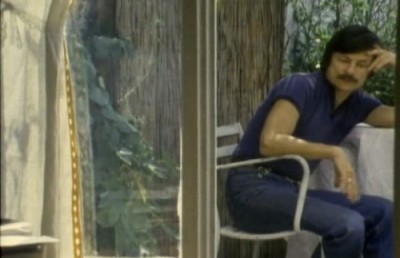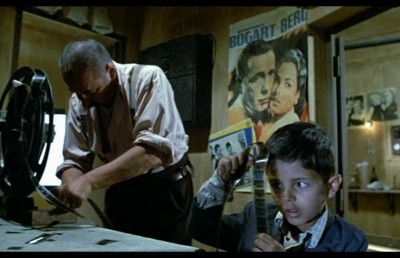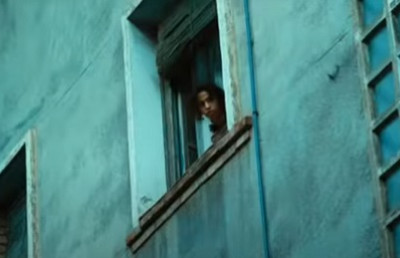There Will Be Blood: A Study in Mise en Scène

Introduction
On a rainy night, in a dark and narrow passage, passers-by see a black woven object on the ground. A superficial observer avoids it for its resemblance with a skinned cooked animal, but a critical spectator picks it up and after some scrutiny, announces, ‘it’s a cramped black bag that, for the lack of light, appears a mystifying shape’.
The above archetype tackles two styles of treating the texts; an emotional way, which makes the viewer think on a subjective level, and a close critical treatment that persuades the critic to contemplate objectively. In order to master the latter approach in film study, a critical reading of a particular film’s mise-en-scène is an intriguing task. In a simplified fashion, John Gibbs (2002, p.5) defines the mise-en-scène as “the contents of the frame and the way they are organized [by the director]”. David Bordwell and Kristin Thompson (2008, p.112) in a more detailed definition write: “mise-en-scène includes those aspects of film that overlap with the art of theatre: setting, lighting, costume, and the behaviour of the figures. In controlling the mise-en-scène, the director stages the event for the camera.” V.F. Perkins (1972, p.74) suggests the same latter idea for a director, “[the way of framing] is the most significant area of control.” It can be reasoned from Bordwell and Perkins’ notions that the more a director controls the mise-en-scène of his films, the more he explores his vision within the frame.
Perkins (1972, p.61) explains the two main components of mise-en-scène: “The fiction movie exploits the possibilities of synthesis between photographic realism and dramatic illusion.” It can be argued based on Perkins’ comments that mise-en-scène is not a static and unchangeable concept, but a fluid existence, which is constantly oscillating between the reality (photographic realism) and the filmmaker’s manipulative treatment of the reality (dramatic illusion).
This text aims initially to clarify the sophisticated reasons for studying mise-en-scène. In addition, it will present an interpretation of the mise-en-scène within the last sequence of There Will be Blood (Paul Thomas Anderson, 2007), in an attempt to elucidate concerns about the elements that exist in the frame, how they are organised by the director and what meanings and philosophy they convey.
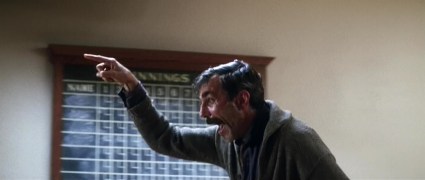
Why Study mise-en-scène
A film, like the black object on the pavement, has more to it than first meets the eye. The amount of events and the tempo of editing distract the audiences’ awareness from the purpose of the image. Perkins (1972, p.85) pins down this point by arguing: “we [audiences] are so busy noticing that we respond rather to our awareness of the device than to the state of mind it sets to evoke.” There are two points that could be understood from his idea:
1. Directors consciously manipulate the image in order to prevent the viewers from ‘forming a state of mind’. As a result, audiences are not able to read films critically, and therefore will be deluded by film’s deception.
2. Perkin presents a proposal; that is, in order to objectively approach a cinematic text, spectators need to think about and glean meaning from images prior to their occurrence. Thus, a critical engagement with films’ images results in comprehending an analytical structure based on the triadic relation of director, device and mise-en-scène. That is, by engaging devices, the director creates the mise-en-scène.
The notion of a device does not entirely refer to the technical elements of filmmaking, but to the director’s decision in creating a film’s mise-en-scène based on some of these elements as well. As Robin Wood espouses in Gibbs (2002, pp.56-57), “a director is about to make a film. He has before him a script, camera, lights, décor and actors. What he does with them (his decision-his choice) is mise-en-scène, and it is precisely here that the artistic significance of the film, if any, lies.” This argument is not as absolute as it desires to be. The main issue is that directors are not always free from the pre-existing constraints that bind them to manifest their own vision within the image. The everlasting paragon is the notorious Hollywood studio system of the 1930s and 1940s and their perpetual interfering in every aspect of filmmaking.
It should be considered that although There Will be Blood is a Hollywood product, P.T. Anderson functions as producer and writer as well as the director; he steers thusly to exercise more power than usual for a Hollywood director.
In order to contextualise the mise-en-scène analysis of Anderson’s film, a series of introductory arguments and explanations are in order. The initial point is that There Will be Blood is dominated by classic mise-en-scène. This concept, in Adrian Martin words, is “an unobtrusive style, which is motivated by the film’s themes and dramatic developments.” In addition, he writes about ‘a balance (coherence) between showing and narrating’ as the result of building a film’s mise-en-scène in a classical manner (cited in Elsaesser and Buckland, 2002a, p.83). The idea of balance refers to the director’s decision in making an even synthesis between cinematic techniques and narrative progression of the film; that is the camera does not suddenly deviate from the film’s narrative, but rather aims to portray the progress of the narrative.
The section of Martin’s ideas that requires clarification is the discussion of coherence. This conception in Perkins’ writing (1972, p.116) “is the prerequisite of meaning. It is the means by which the film-maker creates significance.” Moreover, Gibbs explores this idea more (2002, p.42) by saying: “the film-maker’s aim is to organise the world to the point where it becomes most meaningful but to resist ordering it out of all resemblance to the real world which it attempts to evoke.” It can be reasoned from Perkins’ ideas that in order for a cinematic text to be coherent, it must manifest meaning within the context of the film’s world. Perkins defines this idea as credibility of the film; he (1972, p.121) says: “credibility depends on the inner consistency of the created world, as long as obeys its own logic.”
The next section will explain how Anderson demonstrates the dialectic connection between coherence and credibility of the mise-en-scène and encodes meanings which are logical in the context of the film.
One may wonder why choosing a Hollywood film as a case study is conducive to this text. Gibbs (2002, p.65) contributes to this enigma by suggesting, “Hollywood films may only reveal their qualities if one is thinking about them in terms of mise-en-scène.” There can be a critical understanding of his reasoning; i.e. Hollywood films are not confined to their images exclusively; they are multi-faceted and multi-layered. Nevertheless, this essay accepts Gibbs’ clarification and instead focuses on its main task.
Mise-en-scène
Anderson, up to the chosen sequence, has depicted the characteristics and mentalities of the two main protagonists of the film: Daniel Plainview (Daniel Day-Lewis) and Eli Sunday (Paul Dano). The latter has been shown as a pseudo-prophet, a charlatan and an abject pimp of a false doctrine of Christianity, who makes his way through life by schemes and lies. The former is a hardworking but obnoxious brute oil tycoon, whose hatred towards humanity makes him a memorable character.
The length of the sequence I will analyze is 11 minutes and 50 seconds, which can be broken down into four sections: an introduction of 22 seconds, a first part of 8:52, a second part of 2 minutes and a brief conclusion of 38 seconds. Moreover, the scene is located 2 hours, seventeen minutes and ten seconds into the film; it is the concluding scene of the film.
The first scene starts by showing Eli bringing three glasses of whiskey for himself and Daniel (the significant meaning of the glasses will be explained further on). Anderson’s camera pans to follow Eli as he arrives next to Daniel, who is sitting next to black bowling balls. The seated position of Daniel, and the fact that Eli bends down slightly to serve him, portrays the former as an all powerful figure and the latter as the servant. Furthermore, throughout the entire film, Eli represents himself exclusively as the servant of God. However, by serving Daniel in this scene, he treats Daniel as if he is God.
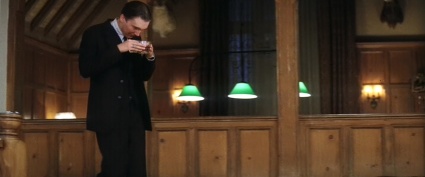
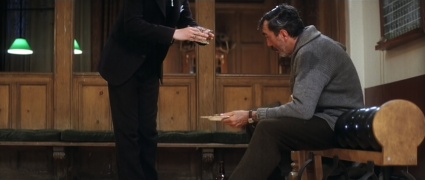
The similarity of the bowling balls’ colour and Eli’s suit is a metaphor for their similar raison d’être. That is, the balls are used to chase and hit pins, and Eli in his black suit resembles the moving force of a bowling ball that chases people (pins) and affects them with his delusive teachings and dehumanising tendencies.
Eli offers the drinks to Daniel, but he declines the offer by a wave of his hand. The refusal of drinks is surprising, since the film has established Daniel as an excessive drinker and a lover of whisky. This rejection has two meanings:
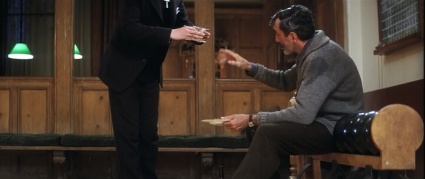
1. Due to the fact that Daniel is about to have a conversation with his nemesis, his sobriety is essential.
2. He rejects the drink because it has been touched or blessed by the false prophet, as a form of unholy communion. Daniel, by saying no to Eli, refuses believing in his God as well as declining the offer of being served like a God.
B) This part of the sequence is of vital importance. Initially, for its valuable contribution to the film’s narrative: it foretells where the plot will conclude. In addition, Anderson depicts the downfall of Daniel in a Darwinian sense through the mise-en-scène (explained in a later section). The scene is comprised of 28 shots, yet only two of them display the two characters in the same frame. In the other 26 shots the characters are separated by editing, which of course is not part of the mise-en-scène (13 shots each), but helps to shape its meaning. Anderson, by devoting the same amount of shots to each character, gives the same space and emphasis to them; by doing so, he enables their personality to develop symmetrically to the extent that the authenticity of their ethos is transparent to the audience.

The first shared shot (eleventh shot) is where Eli proposes a new oil venture to Daniel. Both characters are seen together, signifying that they are in a similar psychological situation. Daniel is in low spirits, because H.W., his son, left him recently; on the other hand, Eli is tormented due to the financial crisis, which his father (God in the Biblical sense) caused by abandoning him. The chosen shot is also a manipulation of Darwinian Theory; according to Darwin (1998, p.26), “no two individuals of the same race are quite alike.” Nevertheless, the initial function of the chosen shot is to show the similar condition of the characters (distorted minds). Furthermore, this shot suggests a metaphorical reading of the characters’ first names (Daniel and Eli, both Biblical names- both with similar roots). It can be argued that Darwin tackles physical appearances and not psychological ones. However, Anderson utilises Darwin’s theory to demonstrate the psychology of his characters: their physical condition as a façade to their distorted souls.
The portrayal of the characters in separate shots individualises them based on the ordeals they are about to experience. Eli is about to be murdered and Daniel is about to go through the Darwinian devolution or ‘reversion’. The fifteenth shot shows Daniel eating a piece of cooked meat with his hand (images 5 and 6). This, in Darwin’s syntax, is the first stage of reversion; the man is no longer a man, but a stage lower, a sub-human or an ‘idiot’. Darwin (1998, p.37) writes, “An idiot is using his mouth in aid of his hands… [And] has no sense of decency.” The lack of decency in Daniel exhibits itself in his bullying of Eli and how he kills the preacher in cold blood, after having made him confess the falsity of his doctrine.

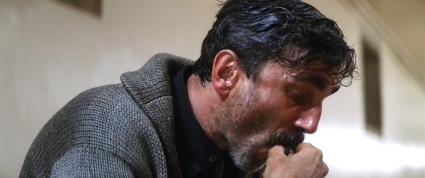
Moreover, the significance of their surnames presents its role in the separated shots. Daniel’s surname (Plainview) reflects the typical mentality of a money obsessed businessman, who is dominated by a shallow observation and acceptance of reality and never dares to consider a second reading of the concept. On the opposite side, Sunday (Eli’s surname) emphasises both church (Sunday, the day of mass and where Eli belongs) and the day God rests after creation. The latter means that Eli is the outcome of the time God is not working; Eli comes late to this world, as he comes late to realise that he needs Daniel’s help to survive.
The next shot in which the two characters are together (shot 27) has a different function from the eleventh shot. In this one, following immediately after Daniel announces that Eli’s proposed fields for drilling are already drained, Anderson defines the power relation between the latter and the former. The oil tycoon is in the dominating position and he practises his power by constantly bullying Eli. This point is demonstrated by dialogue and the way Eli is currently seated, i.e. his shoulders are drooped and his face is miserable. The well-known ‘milkshake’ monologue is the best example of Daniel’s superiority. Anderson, by usage of the camera’s movement (pan to the right), separates Daniel from Eli and his inferior position. Likewise, whilst pacing the frame and pointing his finger up, Daniel encodes three messages:
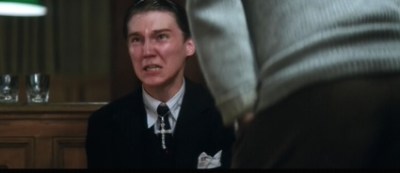
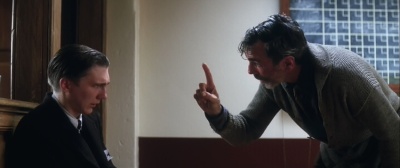
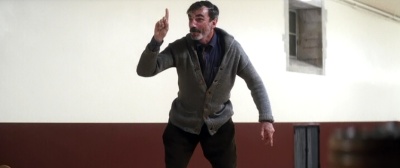
1. The index finger resembles the straw that Daniel speaks about. This is the denotative and obvious meaning.
2. The finger’s direction (pointing up) helps Anderson to represent Daniel as an old priest who by using a parable (milkshake) sends a message to his young and naïve parishioner, Eli.
3. The somehow radical meaning of the pointed finger, which exemplifies a phallus, is a demonstration of an allegorical and psychological rape. This means that by pointing and waving his raised finger around whilst informing Eli that he will have no money and touching him with the finger, Daniel rapes and destroys the preacher’s avarice.
The last shot of this exchange shows Daniel grabbing Eli’s collar and throwing him to the ground. The camera portrays both characters framed in the background through a second frame, while in foreground on the ledge of the actual second frame sit the three glasses. The point of the double framing is that the director emphasises that the audiences are watching a film.
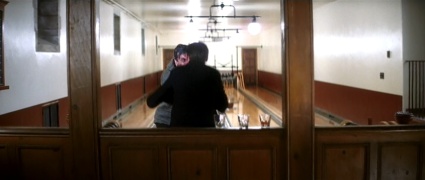
The glasses, mentioned earlier, carry a great deal of significance due to the way they are arranged; two empty glasses together, and at a distance from them to the right, one full glass of whisky. The two empty ones symbolise the empty lives of Daniel and Eli, and how they treat each other like animals throughout the entire film. This means, it is because of their empty lives that Daniel and Eli do engage in any activity, even inhuman and cruel activities, to compensate for their love-less lives. This is similar to what Orson Welles did in Citizen Kane (1941), with the Kane character trying to fill his depressing empty life with valuable objects. In There Will be Blood, Daniel and Eli want to fill this gap with money. On the other hand the half-full glass is a representation of H.W. (Daniel’s son) life, which is filled with love (he is a newlywed) and optimism for the future (the empty half suggests he can end up like his father). It could be claimed that because Daniel keeps drinking whisky, and when in the last sequence of the film Eli drinks whisky, they are in fact drinking the essence of their lives, i.e. whisky resembles life substance in There Will be Blood.
C) The subject matter of the film’s last two scenes’ mise-en-scène is overwhelmed by Darwinian arguments; Darwin (1998, p.37) says, “the principle of reversion means a long-lost structure [primary man] is called back to existence.” The shot that illustrates Daniel in the foreground walking (and chasing) Eli in the background represents the ‘reversion’:
1. The fashion of his walking with the hunched back and open distant hands from body recalls the classic Darwinian model that shows sub-humans and their manner of walking.
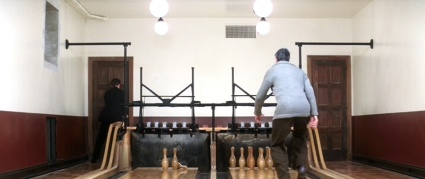
2. The way that he tries to kill Eli is not a modern method of murdering, but more a hunting discipline. The pins that he throws are in fact spears, which primitive humans would use for hunting and killing animals.
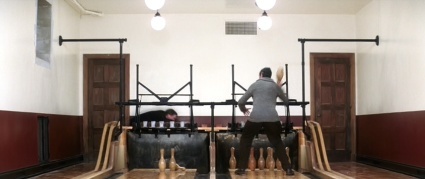
Daniel devolves from being a seated authority figure on the bench to an ‘idiot’ who eats by using his hands, and now in this shot walks and hunts like a primate. In this shot Eli supplicates to Daniel as if he were begging God; Daniel’s age suggests he could be Eli’s father and thus in a Christian reading of the film, the aforementioned is God. Notwithstanding, he is not a merciful and loving God of the New Testament, but an angry God from the Old Testament (specifically Exodus, where he destroys everyone).
The last seconds of this scene (and final moments of the film), when Daniel kills Eli and sits next to him (Image 11), have two significant points:
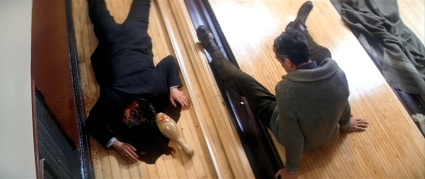
1. Daniel is sitting next to Eli’s corpse while blood is pooling from Eli’s smashed skull and flowing on the ground. I suggest that the cinematographer (Robert Elswit), by choosing a bird’s eye angle, emphasises the point that in the Darwinian sense, everyone apart from these two characters are complete and evolved humans. However, Eli is now a dead man who will dissolve into the circle of life, and Daniel is an absolute devolved man.
2. The fashion of Daniel sitting with buttocks fully on the ground, outstretched legs and hunched back, is a tribute to the cinematic devolved apes in the opening sequence of Stanley Kubrick’s 2001: A Space Odyssey (1968).
The way Eli’s blood is depicted carries a dual meaning:
1. The blood and the way it moves on the ground refer to oil, religion and death: all three concepts march slowly on the earth, and gradually cover everywhere and it is impossible not to be stained by them.
2. The blood is a metaphor for the two characters’ greedy treatment of one’s desires; greed for God, money or even love (the way Daniel is obsessed with the love for his son, and his devolution after his son’s departure).
D) The last shot of the film (seen as a point of view from the character Abel Sunday) illustrates Daniel in the same position as the shot above; however the audience is privileged with a long-shot and observe him in the full scale of the bowling room.

In addition, two closed doors (of a brown-grey color) at the background are located in front of Daniel, which have a strong link to his jacket colour, grey. This colour, as a synthesis of black and white, reflects the duality and ambiguity of Daniel’s character. He can be seen as a successful man (he is a wealthy businessman) or a miserable person (his hatred for humans). He has the opportunity to be a protective father (God) for Eli, but by bullying and killing him, abandons the son. He can be seen as a perfect Darwinian specimen, nevertheless reduced to a sub-human. The doors offer two different paths to him, heaven or hell; Eli’s black suit seals his eternal fate, but Daniel’s grey jacket displays the purgatory in which he lives his life. The confined structure of the room suggests the entrapment of Daniel in this ambiguity and how it is impossible for him to escape the dilemma.
The last line of the film, articulated in the shot when Daniel responds to Abel Sunday’s call, “Mr. Daniel,” with the words, “I am finished,” can be a matter of controversy. In the shooting script (scribd, 2008), Anderson demonstrates Daniel’s emotion while saying this line, ‘satisfied’. However, in the film Daniel articulates his line without any emotion or feeling. The reason may be due to the Darwinian approach to the film’s conclusion: there is no room for feelings and inner thoughts. Daniel is no longer a man, so his animalistic instincts have no aesthetic value for the mise-en-scène’s credibility. It should be depicted in the way Anderson masters it, so the credibility and thus the coherence of the film is untarnished. That is the reason why there is no use of diegetic or non-diegetic music in the last twelve minutes of the film; the Darwinian evolution or devolution happens with no score, and thus the same happens in its contextualised cinematic representation.
Conclusion
Perkins (1972), in order to display the meaning of film in a disciplined system, describes a critical attitude in reading films, which is a theory of mise-en-scène . The objective aim of the theory is to discover a specific film’s meaning that has been created by the director whilst engaging cinematic techniques. Furthermore, the theory informs film scholars and critics as to how a director builds a balanced relation between the coherence and the credibility of the film.
Paul Thomas Anderson, in the last scene of There Will be Blood, creates the balance by representing his vision whilst combining it with Biblical references in general and Darwinian notions in particular. The result is that the audience witnesses a rich cinematic text, woven from different ideas that work together cohesively within the world of the film.
Frame grabs taken from There Will be Blood (2007) Directed by Paul Thomas Anderson [DVD] Los Angeles: Paramount Vantage and Miramax films.
Bibliography
Bordwell, David, Thompson Kristin. Film Art, 8th edition, Boston, Mcgraw –Hill publishers, 2006.
Darwin, Charles. The Descent of Man, New York: Prometheus Books, 1998, orig., 1874.
Elsaesser, Thomas. Buckland, Warren. Studying Contemporary American Film: A Guide to Movie Analysis, London: Arnold Publishers, 2002.
Gibbs, John. Mise-en-scène: Film Style and Interpretation, London: Wallflower Press, 2002.
Perkins, V.F. Film as Film, New York: Penguin Books, 1972.
There Will Be Blood shooting-script (2008). (Accessed 2 November 2008).


